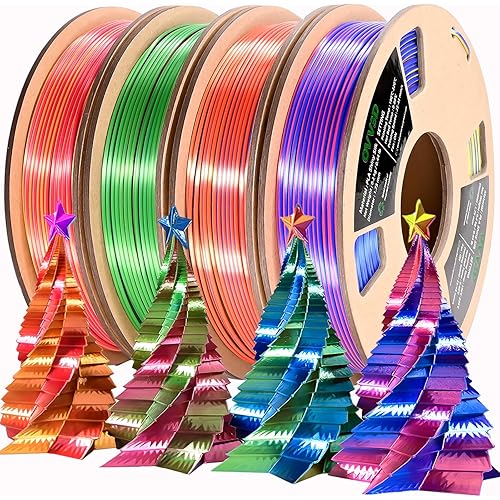HATCHBOX PETG 3D Printer Filament, Dimensional Accuracy +/- 0.03 mm, 1 kg Spool, 1.75 mm








Buy Now, Pay Later
- – 4-month term
- – No impact on credit
- – Instant approval decision
- – Secure and straightforward checkout
Ready to go? Add this product to your cart and select a plan during checkout.
Payment plans are offered through our trusted finance partners Klarna, Affirm, Afterpay, Apple Pay, and PayTomorrow. No-credit-needed leasing options through Acima may also be available at checkout.
Learn more about financing & leasing here.
Selected Option
This item is eligible for return within 30 days of receipt
To qualify for a full refund, items must be returned in their original, unused condition. If an item is returned in a used, damaged, or materially different state, you may be granted a partial refund.
To initiate a return, please visit our Returns Center.
View our full returns policy here.
Recently Viewed
Color: Lime Green
Features
- 1KG (approximately 2.2 lbs) Spool
- PETG (Polyethylene Terephthalate Glycol-Modified) 3D Printer Filament Vacuumed Sealed With Desiccant
- Recommended Extrusion/Nozzle Temperature 230C - 260C (446F - 500F)
- 1.75mm Filament Diameter (Dimensional Accuracy +/- 0.03mm)
- Spool Diameter: 8" - Spool Width: 2.50" - Spool Hub Hole Diameter: 1.25"
Description
HATCHBOX PETG Lime Green Polyethylene Terephthalate Glycol-modified filament is a fine alternative to PLA and ABS, due to its toughness, clarity, and stiffness. Print over a wider range of conditions and enjoy increased durability at a lighter weight. Read more Features & Benefits Tech Spec Each package of PETG Lime Green contains a 1 kg (~2.20 lbs) spool at 1.75 mm filament diameter with a dimensional accuracy of +/- 0.03 mm). We recommend printing at a nozzle temperature of 230°C - 260°C (446°F - 500°F) Multi-Use Make more than just models with 3D printing! Design and bring to life your inventions and other functional pieces for use in everyday applications like custom phone cases, wallets, salt shakers, sculptures, candle holders, dog tags and tons more. The sky's the limit! Your creativity begins with Hatchbox filament. Performance PETG is the ideal polymer for lightweight but durable models and prototypes. Enjoy easy adherence to the print bed, very low odor, high detail resolution, and smooth, glossy finishes on all of your prints. Innovation At Hatchbox, we are proud to provide the tools you need to innovate in life and in work whether a seasoned printer or just starting out. We help you push your ideas forward with the best in 3D printing materials so you can make your designs a reality. Read more Why HATCHBOX? Quality Hatchbox 3D filaments are loved by the printing community for their high-quality composition, offering clog, bubble and tangle-free printing. Every spool is assured to offer the highest caliber of performance possible. That’s the Hatchbox promise. Materials No matter what your latest project calls for, we have a filament to suit any need, from heat resistance and durability, to flexibility and odorless extrusion. Our exhaustive catalog provides the choices you want to help you get the job done quickly and easily. Colors One of the most important factors of any print comes down to color. Hatchbox 3D colors are bold and vibrant. Mix and match bright primaries and nuanced hues with gloss, textured, sparkle, transparent, and even wood and marble-mimicking filaments. Reliability Trust all of your prints to Hatchbox! We strive to make 3D printing an enjoyable and error-free process for our customers. That’s why each filament is carefully formulated and thoroughly tested to save you time and effort every time you print. Read more ABS 3D Pen Filament 16 Color Sample Pack ABS 1.75mm 3D Printer Filament Gray PLA Silk 1.75mm 3D Printer Filament Mint ABS 3D Pen Filament 12 Color Sample Pack PLA 1.75mm 3D Printer Filament Red PLA Silk 1.75mm 3D Printer Filament Sliver Filament Type ABS ABS PLA ABS PLA PLA Diameter 1.75mm 1.75mm 1.75mm 1.75mm 1.75mm 1.75mm Color 16 Color Sample Pack Gray Silk Mint 12 Color Sample Pack Red Silk Silver Benefits Prints at Higher Temperatures | Durable Prints at Higher Temperatures | Durable Less Warping | No Heating Bed Required Prints at Higher Temperatures | Durable Less Warping | No Heating Bed Required Less Warping | No Heating Bed Required
Manufacturer: HATCHBOX
Brand: HATCHBOX
Item Weight: 2.2 pounds
Package Dimensions: 8.74 x 8.39 x 2.87 inches
Color: Lime Green
Material Type: Polyethylene Terephthalate Glycol
Manufacturer Part Number: 3D PETG-1KG1.75-LMGRN
Date First Available: March 17, 2021
Frequently asked questions
To initiate a return, please visit our Returns Center.
View our full returns policy here.
- Klarna Financing
- Affirm Pay in 4
- Affirm Financing
- Afterpay Financing
- PayTomorrow Financing
- Financing through Apple Pay
Learn more about financing & leasing here.























